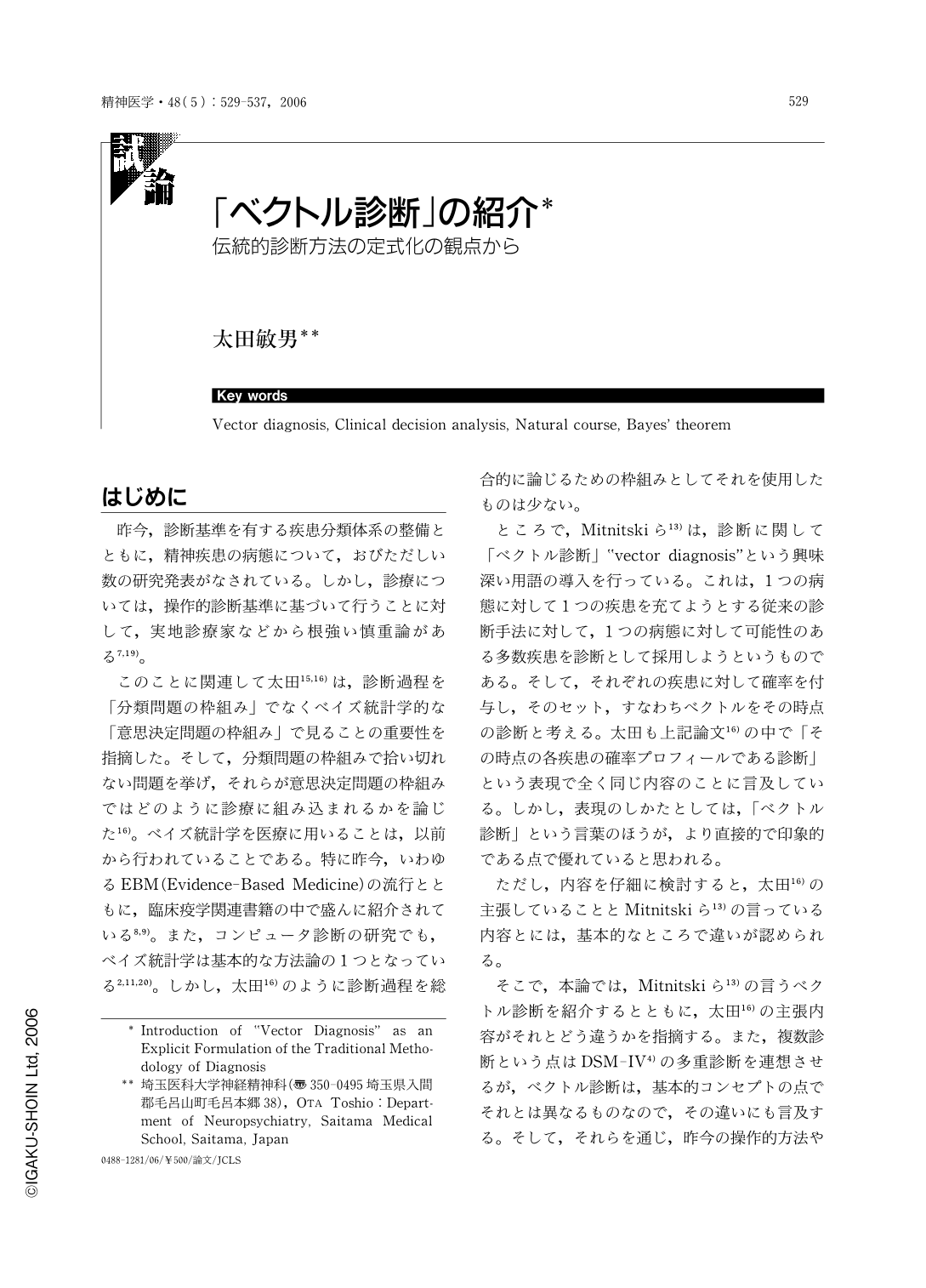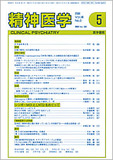Japanese
English
- 有料閲覧
- Abstract 文献概要
- 1ページ目 Look Inside
- 参考文献 Reference
はじめに
昨今,診断基準を有する疾患分類体系の整備とともに,精神疾患の病態について,おびただしい数の研究発表がなされている。しかし,診療については,操作的診断基準に基づいて行うことに対して,実地診療家などから根強い慎重論がある7,19)。
このことに関連して太田15,16)は,診断過程を「分類問題の枠組み」でなくベイズ統計学的な「意思決定問題の枠組み」で見ることの重要性を指摘した。そして,分類問題の枠組みで拾い切れない問題を挙げ,それらが意思決定問題の枠組みではどのように診療に組み込まれるかを論じた16)。ベイズ統計学を医療に用いることは,以前から行われていることである。特に昨今,いわゆるEBM(Evidence-Based Medicine)の流行とともに,臨床疫学関連書籍の中で盛んに紹介されている8,9)。また,コンピュータ診断の研究でも,ベイズ統計学は基本的な方法論の1つとなっている2,11,20)。しかし,太田16)のように診断過程を総合的に論じるための枠組みとしてそれを使用したものは少ない。
ところで,Mitnitskiら13)は,診断に関して「ベクトル診断」“vector diagnosis”という興味深い用語の導入を行っている。これは,1つの病態に対して1つの疾患を充てようとする従来の診断手法に対して,1つの病態に対して可能性のある多数疾患を診断として採用しようというものである。そして,それぞれの疾患に対して確率を付与し,そのセット,すなわちベクトルをその時点の診断と考える。太田も上記論文16)の中で「その時点の各疾患の確率プロフィールである診断」という表現で全く同じ内容のことに言及している。しかし,表現のしかたとしては,「ベクトル診断」という言葉のほうが,より直接的で印象的である点で優れていると思われる。
ただし,内容を仔細に検討すると,太田16)の主張していることとMitnitskiら13)の言っている内容とには,基本的なところで違いが認められる。
そこで,本論では,Mitnitskiら13)の言うベクトル診断を紹介するとともに,太田16)の主張内容がそれとどう違うかを指摘する。また,複数診断という点はDSM-IV4)の多重診断を連想させるが,ベクトル診断は,基本的コンセプトの点でそれとは異なるものなので,その違いにも言及する。そして,それらを通じ,昨今の操作的方法や分類体系を踏まえたうえで,伝統的診断法の長所を再認識すべきであることを論じたい。
なお,診断に関係する用語として診断,疾患,障害,範疇などさまざまなものがあるが,本稿では,太田16)と同じく,疾患分類の単位としての診断と診断行為としての診断の混同を避けるため,前者を疾患と呼び,後者を単に診断と呼ぶことにする。ただし,Mitnitskiら13)の論文の紹介に限り,原著者の用語を尊重して,診断単位を診断範疇と呼ぶ。
Mitnitski et al's idea of “vector diagnosis” was introduced and discussed in relation to the formulation of the traditional methodology of diagnosis. The idea has part of its methodological procedures in common with conventional Bayesian diagnosis, where Bayes’ theorem is used to calculate probabilities after additional information is available. However, the Mitnitski idea is unique in that it adopts the “vector”, or the set of probability values of all the exclusively possible diseases (disorders), as the diagnosis, instead of adopting the single most probable one. The same idea may have been known implicitly to clinicians as well as to researchers and has already been referred to explicitly in my previous paper, but the wording of “vector diagnosis” appears better in that it is impressive and represents the essential part of its idea clearly and correctly.
Specifically, however, Mitnitski et al's methodology has some limits and problematic issues, among which the issue of diagnostic categories is the most serious one. In addition to the nosological classification factor, the degree of seriousness and the probability of diagnosis factors were also used for diagnosis, making the categorization too complicated and possibly unreasonable. It has often been pointed out that diseases have their own specific natural history. Clinicians who meet with a disease at its earliest stage will have to keep observing the course of the disease thereafter for months or even for years to make a correct diagnosis, because its clinical picture may be too immature at that stage. It is in such situations that the Bayesian methodology shows itself at its best. Thus, it should be emphasized that diagnostic categories in the vector diagnosis include the natural history or clinical course component more fully. If such definitions are employed, the idea will be not only useful but also enlightening for clinicians.

Copyright © 2006, Igaku-Shoin Ltd. All rights reserved.


